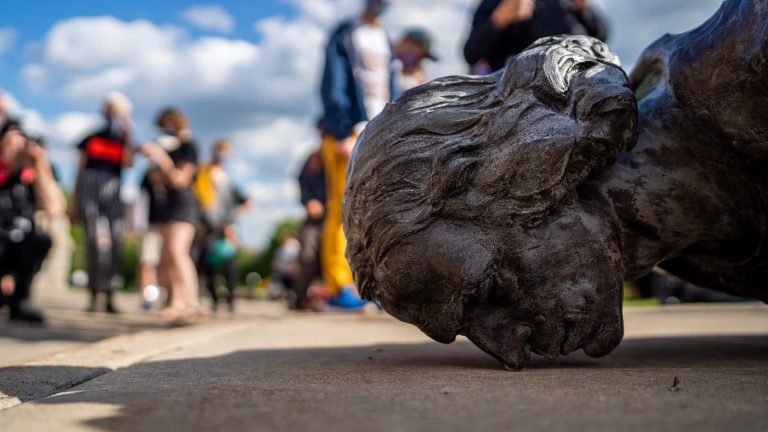People are complicated, and the amount of ink spilled attempting to analyze the human condition could fill oceans. Indeed, the majority of all philosophy, psychology, sociology, economics, and their related fields has been devoted to trying to solve the mystery that is man. Yet, if we listen to the prevailing narrative in 21st century America, all of this work may as well have been in vain.
It turns out, we are told by professional academics and their students, that all of human experience can be reduced down to a couple of binaries. Everyone is either good or bad, racist or anti-racist, and where anyone falls on these axes can be deduced by their skin color and ancestry rather than by any actions they may have taken. The new progressive bible, White Fragility, declares that, in the words of the late Christopher Hitchens, you are born sick and commanded to be well (assuming, of course, that you are white or of European descent).
Iconoclasts in the streets are tearing down statues and demanding that names of “problematic” people be scrubbed from buildings, roads, cities, even states.
What designates a particular person as problematic? That turns out to be the tricky part. Of course, there can be little or no logical objection to removing statues that honor horrific atrocities and the men who perpetrated them. We wouldn’t want statues of Hitler, Stalin, or Mao in our public squares. There are equally good reasons to object to statues honoring the Confederacy and its defenders, due to the unbreakable link between the southern states’ secession and the institution of slavery.
However, the protests and vandalism of statues have not been limited to the Confederacy. There have been attacks on statues of George Washington, Christopher Columbus, Thomas Jefferson, Ulysses S. Grant, Mahatma Gandhi, and various abolitionists who actively fought against slavery. A few blocks from my Washington, DC apartment, protesters attempted to tear down a statue of Abraham Lincoln, commissioned by freed slaves to commemorate the Emancipation Proclamation.
There are several issues here, not the least of which involve a profound ignorance of history and a childish propensity for violence. But to me, the most troubling aspect of all this is the apparent loss of our ability to see the totality of an individual life, with all its inherent moral complexities.
You see, we like to talk of “good people” and “bad people” as two non-intersecting circles in a Venn diagram. It’s not hard to understand why. Tall people aren’t short, fat people aren’t thin, old people aren’t young, so how can a bad person be good? These are easy categories for our pattern-seeking brains to carve out and lump our fellow human beings into, and that, apparently, is comforting. The error lies in assuming the adjectives “good” and “bad” can be used to describe a whole person throughout the duration of their lifetime, rather than being temporary conditions that come and go all the time, and which can even coexist together in the same person. We see no contradiction in a person being simultaneously hungry and angry. Even supposed opposites like happiness and sadness can comingle within a single mind, a condition we could describe as wistful melancholy. Nor would we write off a historical figure as “a sad person” simply because they experienced a few bouts of depression in their lives. Everyone experiences both happiness and sadness in the same way that everyone performs both good and evil acts over the course of many years.
There is a series of videos on YouTube, the title of which escapes me, aimed at converting atheists to Christianity. In these videos, a well-meaning evangelist approaches bystanders on the street and asks them if they think they are a good person, to which they invariably answer in the affirmative. He then asks whether they have ever lied or stolen, to which they also say yes. In his big “gotcha” moment, the interviewer then hits them with: “how can you say you’re a good person when you admit to being a lying thief?”
The point of this exercise is to convey that we are all miserable sinners and that it is only through the grace of God that we can be redeemed. However, to any logical person the flaw in the method is obvious. Telling a fib or swiping a candy bar as a child doesn’t make you a bad person. These are bad actions, but it’s insane to let those few missteps, possibly taken due to ignorance, an underdeveloped sense of ethics, or simply a lapse in judgment, define an entire person as wicked. To do so would be to ignore all the acts of charity, kindness, and love that these people have no doubt performed in those moments when they are not lying or stealing.
It could be argued that the proper approach to evaluating a life consists in tallying up all the good deeds and all the bad ones, applying some weighting system to adjust for the severity of the crimes or magnanimity of the boons, and seeing which comes out on top. I think this approach rather misses the point, however. Instead, I would encourage people to abandon the notion of “good people” and “bad people” altogether. The alternative would be to allow ourselves to celebrate the good within a particular person while simultaneously condemning the bad. We need not neglect the 49 percent saint on account of the 51 percent sinner. We can acknowledge both, and distribute praise and censure accordingly.
A couple of examples will be instructive. Let’s take Christopher Columbus first. It is hard to deny that he did some pretty terrible things and was not what you would call a beacon of morality. His role in propagating slavery and his treatment of indigenous peoples deserves, at minimum, a healthy degree of condemnation, no question. On the other hand, his expedition bringing European culture in contact with the New World is undoubtedly worth celebrating. The prominent and obviously left-leaning scientist Neil DeGrasse Tyson, speaking on Joe Rogan’s podcast, described it as the most significant achievement in human history. If we can’t put up a statue to commemorate that, what else is there? But note that we need not weigh all aspects of Columbus’ life and conclude that he did more good than bad. We can acknowledge that he was a mostly bad guy who did a great thing, and leave it at that.
We can take a similar approach to the composer Richard Wagner. As a musician, I like to use Wagner as an example both because I happen to know quite a lot about him and because he represents a pretty clear example of a louse who managed to reach the stars. Wagner’s own letters portray him as manipulative, selfish, narcissistic, and anti-Semitic. He was a typical artist all too aware of his own talents who expected the rest of the world to grovel before him and his genius. He was also one of the four or five greatest composers who ever lived. Now, what to do with this complex picture of a man? Can we sum his life’s achievements and sort him neatly into the “good” or “bad” pile, like Santa Claus dishing out coal and candy? Not really. I have no idea what the moral weight of writing an opera may be, and it’s certainly difficult to offer any kind of utilitarian calculation of the combined good and evil he put into the world. But there’s no reason to try. We can—and in my opinion must—honor Wagner’s contributions to music with statues, theaters, and whatever else we want to slap his name on, while recognizing that so doing does not constitute an endorsement of his abhorrent personal life.
One final and more relevant example can be found in America’s founders, George Washington and Thomas Jefferson. Both men owned slaves, and in Jefferson’s case one could argue that they were not treated especially well, even by the standards of the time. Washington, as a general during the American Revolution, was a killer. He slaughtered human beings without reservation (and indeed, we could raise the same objection to almost all military monuments). Slavery is perhaps the most abominable institution ever perpetrated by the human race, and murder remains our most reviled crime. I would never presume to offer such feeble excuses as “everyone was doing it at the time” or “all’s fair in love and war.” There can be no justification for these actions.
However, Jefferson also wrote that “all men are created equal,” beginning a unique document in the history of our species. He created a framework for equal treatment under the law that would become the United States, the freest, most just, and most prosperous society ever known. As the country’s first president, Washington voluntarily surrendered power when offered the chance to rule as a monarch, setting the standard by which all future presidents would be judged and publicly putting the wellbeing of his country before his own. These deeds are largely without precedent, and have resulted in more human flourishing than practically any other acts taken at any other time. It should not be controversial to honor what they did, even as we recognize their all too human failures.
I could go on: Gandhi was a hypocrite who forced his wife to refuse life-saving medicine on religious grounds, but later partook of the same treatment himself. Martin Luther King, Jr. was a serial adulterer. Most people living before the 20th century harbored some form of racism or prejudice. But these facts need not erase the contributions to non-violent resistance, civil rights, and Western Civilization in general, nor our recognition and celebration of them.
People are complicated, and people are flawed. If we expect our heroes to be saints, we will soon find that we have no heroes left (even Mother Theresa palled around with some pretty unsavory characters while raising money for the Church). We must not fall into the trap of regarding any bad deed as capable of erasing an entire life’s work from history. The current vogue of viewing historical figures only through the lens of their moral failings is a kind of myopia that is in danger of making the whole world blind.
So yes, if we want to take down monuments that send the wrong message or honor the wrong thing, let’s absolutely have that conversation, as long as we can do it as peaceful communities and not angry mobs. But let’s also recognize that no one is wholly good or wholly evil, and when it comes to defining an entire life based on a handful of bad choices, let he who is without sin topple the first statue.














Thank you for this article Logan, this is precisely how I feel about the subject… except I would add one more thing. Those that are destroying and defacing our statues and monuments that are on private or government property should face very HARSH penalties.
I keep seeing this happening and in many of the cases I wonder WHY it wasn’t stopped. Why the local or state government officials respond with something to the effect of “yea I tried to get that removed years ago…” but never any comment about stopping or catching the law breakers that destroyed property.
It seems everybody is offended by something right now and they have no problem with violently taking their issues to the streets with little to no resistance from the local governments.
@Soren Nothing is done to these dime store hood paid criminals because it is not a “genuine” movement/protest, it is controlled from the beginning to allow their thugs to do things like tear down historical landmarks (which is an old tactic marxist scum use to legitimize erasing local culture) in the name of “justice” and get away with it while at the same time using the mockingbird liars behind the media to blow things out of proportion and make it seem like chaos in the streets…,
.